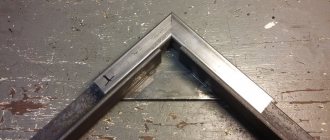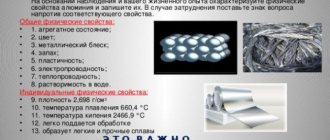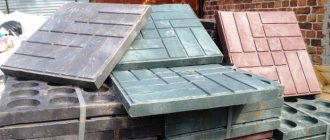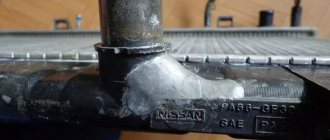Profile pipes today are in demand in many industries - automotive, construction, metallurgy. And not only large enterprises, but also individuals become buyers of products. This makes the production of profile pipes a very promising business area. And since not every region has a factory for the production of this type of product, why not take advantage of the currently free niche and launch your own production workshop? Here, as in any other area of business, it is very important to obtain high-quality products at the output. And for this, it would not hurt an entrepreneur to thoroughly study the production technology and monitor the market to identify the needs of potential buyers.
Our business assessment:
Starting investments – from 800,000 rubles.
Market saturation is average.
The difficulty of starting a business is 5/10.
And it’s better to start with a mini-plant for the production of profile pipes, rather than a large-scale complex enterprise, to start operating - this way the entrepreneur will have the opportunity to test the waters and understand how in demand the products produced are in a particular market. In addition, developing a small workshop is much easier than immediately launching a powerful line.
Purpose and types of profile products
With the help of profile pipes, various metal structures are assembled, differing in size and purpose: frames, hangars, all kinds of greenhouses. Round type products are inconvenient to use in this case; the same applies to main-type profile pipes.
To make sure that the production of profile pipes is a very relevant topic, a brief overview of the areas of their use will help:
- Standard configuration products . In addition to the usual use in the construction of pipelines, scaffolding, cable protection, irrigation systems and all kinds of fencing are assembled from products of this type.
- Trunk profiles . They are used to construct large-sized pipelines, which are characterized by constant pressure fluctuations: they act as supports. In the manufacture of these products, the manufacturer's specifications or customer requirements are mainly used.
- Rolled metal profile type with increased chemical resistance . Scope of application: food, chemical and pharmaceutical industries.
- Mechanical engineering profile . They are used to make automobile pistons, shafts, cylinders and bearings.
The cross-sectional shape of the profiles can be different - oval, flat-oval, square, rectangular, polygonal. In some cases, when there is a corresponding order, it is possible to produce triangular, hexagonal and other non-standard profiles.
The exact method of manufacturing profile products that was used directly affects its properties:
- Hot rolled profiles without seams. An excellent option in situations where a high level of strength is required. Most often, they have good anti-corrosion protection, tolerating aggressive chemical environments well.
- Cold rolled (standard) profiles. These products are characterized by great elasticity, allowing them to withstand serious pressure fluctuations.
- Electric welded cold rolled profiles. This product is characterized by strength and durability, subject to proper use.
If the production of profile steel pipes is widespread, then the list of necessary equipment may undergo adjustments, depending on the purpose of the product. The business plan for the production of profile pipes has a direct impact on making some changes to its scheme.
Who should sell finished products to?
The price of a machine for making a profile pipe will pay off the faster the sooner sales channels are established. And the main bet here should be placed on the wholesale buyer. After all, this will allow the entrepreneur to immediately ship the manufactured products, rather than storing them while waiting for customers.
In any field, it is quite difficult for beginning entrepreneurs to conclude profitable contracts with wholesalers. Surely, first you will have to adapt to the client, reducing product prices.
And even making a profile pipe with your own hands in an empty garage will require a certain amount of advertising from the businessman. What options are possible here? You can try advertisements in newspapers, articles in specialized magazines, or your own website on the Internet.
How to make a profile pipe
To produce a square or rectangular profile, you will need only one machine - a rolling machine, which has all the necessary functions for forming this type. In this case, you need to purchase ordinary steel pipes with a round cross-section and modify them with a rolling mill (read: “How to roll pipes - options and methods”). The resulting products will have excellent visual identity with the ideas of ordinary consumers about what a rectangular profile should be.
As for technological considerations, such products are quite far from professional performance. Rolling a finished round pipe is an acceptable option in setting up the production of products that will not be used to solve serious problems - building hangar frames or residential buildings. From profiles that have undergone deformation by rolling, it is possible to produce frames for outdoor advertising, furniture, decorative interior elements, and to cover the needs of private construction.
Consumer interest in this product is ensured, but it will not be possible to build safe and reliable structures from it. Organizing the production of higher quality products will require a full production cycle of profile pipes, which consists of a number of successive stages. As a result, you will have to purchase additional machines for the production of metal pipes. The increased financial costs in this case are fully compensated by the expansion of the market for finished products.
Application
We are dealing with a material that has enormous bending strength.
There is an old experiment on strength of materials:
- A simple structure is assembled: a rectangle of four slats fastened with nails. A rectangle is not a rigid figure, and it arbitrarily changes its geometry in one plane;
- At the second stage of the experiment, a paper sheet is glued to the slats. Plain A4 paper. So: after the glue dries, not a single person has the strength to change the geometry of a rectangle of slats in one plane.
In our case, bending a square profile pipe will try to change the geometry of a thick steel sheet, not a piece of paper. Or rather, two sheets - two of the four sides of a square pipe. The strength will automatically be, politely speaking, somewhat higher.
This is not training for drunk climbers, no. The youths clearly demonstrate the strength of a thin square pipe
But our hero is not suitable for a pipeline: the cross-section at the same material consumption is smaller than that of a round pipe, and the pipe can withstand less internal pressure.
Hence the areas of application:
- Elements of load-bearing metal structures . A square pipe is used where it is desirable to combine a more or less decent appearance with significant strength. If aesthetics are not important, builders often use an I-beam to make long spans, and the trusses that support it are assembled from a square pipe.
In addition to significant strength, the flat walls of a square pipe are convenient for installation: they can be connected even without welding, with bolts and studs;
- Furniture frames . By the way, not only a square is used here: rectangular pipes 20x40, for example, often serve as the basis for book and kitchen shelves.
For school furniture, the strength of square tubes is a godsend. Children
- Greenhouse Basics . All the same 40x20 tubes are used after processing with a simple pipe bender as arches, and thin square 20x20 tubes serve as jumpers. Assembly can again be carried out with bolts through through holes;
- Car and trailer frames . Flexural strength with minimal weight - after all, any transport spends fuel on its own transportation - it comes in very handy;
- Railings, fencing . A fence made of a square pipe combines a quite decent appearance with durability: it is not afraid of vandalism, drunk passers-by and minor contacts with cars.
Of course, a square pipe can also be used to make a rigid frame for a lightweight corrugated fence. Material consumption will be minimal, and strength will be quite sufficient.
Advice: so that such a fence is not afraid of corrosion, a square galvanized pipe would be an excellent solution.
However, it also has a weak spot - the ends, on which the zinc layer is missing.
The simplest polyethylene plugs will protect them from moisture.
However, polyethylene will be safe from the playful hands of young passers-by only if the pillars are high; if we are talking about a low fence, it is better to weld the ends with a galvanized sheet or some other decorative elements.
- The square pipe serves as material for a variety of arches and canopies that serve as protection from precipitation . We are, of course, talking about the frame: the planes are made of corrugated sheets, tarpaulin or polycarbonate. Bending a pipe in the form of an arch is possible using both the simplest hand rollers and complex high-performance lines.
Here we have the simplest device for bending a square pipe. As you can see, most of the components can be found in the garage or scrap yard
Full production cycle of profile pipes
The full cycle of manufacturing profile electric-welded products includes the following operations:
- Strip processing.
- Forming and welding of round profile blanks.
- Profiling a round pipe.
- Quality control test.
- Heat treatment.
Metal strip is used as the initial raw material from which the blanks are created - sheet steel of the required grade, supplied to production in roll form. Typically, low-alloy or carbon steel is used for these purposes. It is best that the sheet metal is supplied directly from the metallurgical plant: this will reduce the purchase price by an order of magnitude and be sure that each unit of goods will pass the appropriate quality control (pro
By what principle is a profile pipe subjected to rolling and inspection?
Profiling a cooled workpiece includes the following cycles:
- The rolled product undergoes rolling, which gives it the most uniform round shape along the entire length of the workpiece.
- A round pipe is crimped on four sides on a profiling machine: this allows the rolled metal to be given the required cross-sectional shape.
The need for the second technological stage arises in situations where it is necessary to produce square, rectangular or polygonal profile pipes. Flat-oval and oval profiles are quite satisfied with rolling using the first, control rollers (about
Types of sizes according to GOST
Square steel pipes differ from each other:
- According to production technology (manufactured according to the requirements of GOST 13663–86), there are:
- seamless (with cold and hot deformation);
- electric welded.
- According to regulatory requirements and properties for chemical composition and mechanical characteristics, there are two groups:
- A – manufactured according to GOST 380–2005;
- B – cast according to GOST 1050–80.
- Standard dimensions for square products are determined by GOST 8639–82.
What equipment is needed
What kind of equipment is purchased for the production of profile metal pipes is directly influenced by the enterprise’s demands for quality level and sales markets. For example, if a product is produced for furniture shops, small construction firms and advertising companies, there is no need for high-performance equipment. The main criteria when choosing the right equipment are the level of start-up capital and expected production volumes.
A standard line for the production of profile pipes includes the following mechanisms:
- Machines for unwinding, preparing and processing sheet metal.
- Mill forming a round section.
- Welding unit.
- A device for cutting edges on welding seams.
- Cooler.
- Mill for producing polygonal pipes.
- Cutter for finished products.
On production lines, both full automation and the possibility of using manual labor can be used. Automated lines are more productive, although their cost is higher. The equipment of standard lines includes only rectangular shafts.
In addition to equipment costs, the enterprise estimate will include the purchase of rolled products, rental costs and wages for workers. Typically, one production line requires the participation of two people - a machine operator and a helper. In addition, you will definitely need a technologist and laboratory assistants who will control the quality of the product. Thanks to the wide popularity of profile pipes, even small enterprises are guaranteed good profits and the presence of regular customers. The main thing is to organize everything correctly, without missing a single production cycle.











